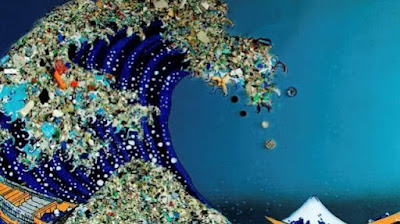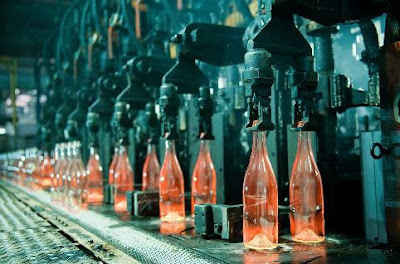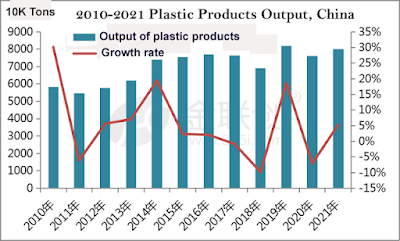- How much plastic is in the ocean?
- It can almost wrap the entire earth!
Plastic Ocean
We consume plastic products frantically and ignore plastic waste, which means that this huge amount of man-made substances has already left dirty marks on the earth. Today, approximately one-third of the nearly 300 million tons of plastic produced annually are thrown away immediately after use. Most of the waste plastic will be incinerated in landfills, and there is likely to be a residue; and most of the remaining part will eventually flow into the sea. The scientist Jan Zalasvich of the University of Leicester in the United Kingdom said: "If all the plastic made in the last few decades was clingfilm, there would be enough to put a layer around the whole Earth." This sounds suffocating.

Some of the plastic that flows into the ocean will be washed up on the coast, and some will be eaten by wild animals, but most of it will remain in the ocean and be broken into small pieces there. We don’t know how much plastic waste is in the ocean; we don’t know what potential impact these plastics have on the health of marine life; and we don’t know how long it will take for these plastics and their impact on the ocean to completely disappear.
How much plastic is in the ocean?
In 1997, when American oceanographer Charles Moore crossed the Pacific Ocean from Hawaii to California, he found a huge ocean area with floating rubbish-this area is now called the "Super Pacific Garbage Strip." Soon after, the same rubbish concentration zone was also found in other sea areas. As a result, the problem of marine rubbish entered the public eye.
These marine garbage patches are created by ocean currents and eddies on the surface of the ocean: just as foam gathers in the center when coffee is stirred, anything caught by these currents will be dragged to the center of the vortex. They circulate between the coasts on both sides of the equator. It is clockwise in the northern hemisphere and counterclockwise in the southern hemisphere. In the Indian Ocean, the North Pacific, the South Pacific, the North Atlantic and the South Atlantic, there are five largest marine debris concentration zones. This year, Moore said that he had found an area in the Pacific Circulation, where a large amount of garbage was gathered, so much that "people can walk on it."
Great Pacific Garbage Patch
How serious is the marine litter problem now? Looking at the blue planet, 70% of the garbage in the ocean is plastic products, said Richard Thompson, a marine biologist from the University of Plymouth in the United Kingdom. Marcus Eriksson of the Five Circulation Research Institute led an international team who intercepted and counted the trash on the sea through the barrier behind the ocean research ship. Most of these garbage are water buckets, bottles, plastic bags, disposable packaging and plastic waste such as polystyrene foam. The research team collected data 24 times in 6 years and found that the area with the highest density of plastic waste has about 10 kilograms of plastic per square kilometer of the sea surface-equivalent to about 800 plastic beverage bottles. From this they estimate that a total of 5.25 trillion pieces of plastic garbage with a total weight of more than 260,000 tons are floating on the ocean.
To what extent will this situation develop? According to data from the Plastics Industry Association, plastic production increased from an average of 1.5 million tons in the 1950s to 299 million tons in 2013. The proportion of recycled parts is very low, and most of these materials are directly discarded after use. For example, in 2012, only 9% of the 32 million tons of plastic waste generated in the United States was recycled.
Plastic Particles in the Ocean
Surprisingly, the data collected by the Erickson team showed that the total amount of plastic waste in ocean currents did not increase significantly with the increase in the total amount of plastic flowing into the ocean. Oceanographer Carla Ravendlaw from the Woods Hole Marine Education Association in Massachusetts, USA, also came to the same conclusion. He combed out the voyage data in the North Atlantis Sea and the Caribbean Sea in recent decades. , Although the amount of directly discarded plastic has greatly increased, the total amount of marine debris in the world is fairly constant. So, where did all the plastic go?
Plastic decomposes faster than we thought. The answer may be: the sun and the waves grind the plastic garbage into tiny pieces. The disappeared plastic may have become fine particles suspended in the water, and large trawl nets cannot catch these fragments. According to estimates of the total amount of plastic flowing into the ocean, there may be millions of tons of fine plastic fragments in the ocean.
In July 2014, André Scorzal of the University of Cadiz in Spain and a group of international marine scientists calculated that the total number of plastic floating in the ocean was between 7,000 and 35,000 tons. Erickson's team also estimated that there should be 35,500 tons of plastic fragments less than 5 mm wide. But both of these values seem to be low, and the million tons of these fragments should be found in the water.
At present, scientists have realized that, possibly due to the larger grid of the trawl, smaller particles will pass directly through the net. Therefore, a large part of small plastic fragments will be missed in the data collection process.
Erickson also said that in addition to the small plastic particles being missed, there are also some plastic products that may be frozen in the ice and cannot be counted. In July 2017, his team discovered that in the Arctic Ocean sea ice, there are 234 plastic particles per square meter. This is several orders of magnitude higher than the severely polluted ocean current. He believes that when sea water turns into ice, it will carry and concentrate small pieces of plastic, so sea ice will accumulate more pieces of plastic than sea water. When the sea ice area of the Arctic Ocean shrinks to its lowest point, it is only 5 to 6 million square kilometers. From this, it can be inferred that the amount of plastics in it is quite large. If the ice layer melts, these substances will be released into the sea again. Some plastic fragments are heavier than water and will sink, while others will become phytoplankton colonies or gather with other plastic fragments and fall to the seabed like falling snowflakes. Currents help to promote this process.
Recently, Erickson’s team has discovered other areas where plastic is accumulating: a large number of plastic fragments with a density higher than seawater fall like snowflakes and eventually deposit on the seabed. The 12 sediment cores and 4 coral specimens collected during 7 deep-sea expeditions in the Atlantic, Mediterranean, and Indian Oceans show that the density of plastic fragments in the sediments here is more than 4 times higher than that in the shallow sea-each square meter contains about 800,000 pieces of plastic fragments.
However, people do not know the specific density of tiny debris in the ocean, because there is no better way to calculate anything less than 3 mm. Tracy Mincer, a marine geochemist at the Woods Hole Oceanographic Institute in the United States, has discovered a solution: scanning seawater with a special laser scanning microscope, which can distinguish 2 to 20 millimeters in size of plastic fragments. If this technology is mature, scientists can measure and estimate the number of suspended plastic fragments in the ocean, and these "slippage fish" may have the greatest impact on marine ecology. We know that marine creatures such as seabirds, sea turtles, whales, etc. will eat plastic garbage by mistake, and they are more likely to die from suffocation or starvation due to a clogged stomach. For smaller marine organisms, the impact will be more complicated.














